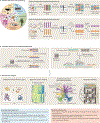Sequencing-based methods and resources to study antimicrobial resistance
- PMID: 30886350
- PMCID: PMC6525649
- DOI: 10.1038/s41576-019-0108-4
Sequencing-based methods and resources to study antimicrobial resistance
Abstract
Antimicrobial resistance extracts high morbidity, mortality and economic costs yearly by rendering bacteria immune to antibiotics. Identifying and understanding antimicrobial resistance are imperative for clinical practice to treat resistant infections and for public health efforts to limit the spread of resistance. Technologies such as next-generation sequencing are expanding our abilities to detect and study antimicrobial resistance. This Review provides a detailed overview of antimicrobial resistance identification and characterization methods, from traditional antimicrobial susceptibility testing to recent deep-learning methods. We focus on sequencing-based resistance discovery and discuss tools and databases used in antimicrobial resistance studies.
Conflict of interest statement
Competing interests
The authors declare no competing interests.
Figures



Comment in
-
A genomic approach to microbiology.Nat Rev Genet. 2019 Jun;20(6):311. doi: 10.1038/s41576-019-0131-5. Nat Rev Genet. 2019. PMID: 31101903 No abstract available.
References
-
- Cosgrove SE & Carmeli Y The impact of antimicrobial resistance on health and economic outcomes. Clin. Infect. Dis 36, 1433–1437 (2003). - PubMed
-
- Hawkey PM The growing burden of antimicrobial resistance. J. Antimicrob. Chemother 62 (Suppl. 1), i1–i9 (2008). - PubMed
-
- Acar JF Consequences of bacterial resistance to antibiotics in medical practice. Clin. Infect. Dis 24 (Suppl. 1), 17–18 (1997). - PubMed
-
- Cosgrove SE The relationship between antimicrobial resistance and patient outcomes: mortality, length of hospital stay, and health care costs. Clin. Infect. Dis 42 (Suppl. 2), 82–89 (2006). - PubMed
-
- Tillotson GS & Zinner SH Burden of antimicrobial resistance in an era of decreasing susceptibility. Expert Rev. Anti. Infect. Ther 15, 663–676 (2017). - PubMed
Publication types
MeSH terms
Substances
Grants and funding
LinkOut - more resources
Full Text Sources
Other Literature Sources
Medical

